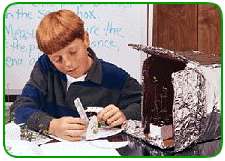| |
Let Wisconsin Fast Plants Grow on You!
Whitney Crispen Hagins
Medfield High School,
Medfield, Massachusetts, 02052
What if you could provide each of your students with an experiment that is inexpensive and convenient, takes up little space, and can be tailored to fit the time you have available in the classroom? And even more important, what if your students really enjoyed working with it?
The answer to both these questions may be found in Wisconsin Fast Plants materials; these plant specimens (Brassica rapa) are selectively bred for rapid development, producing a practical and manageable research organism for classrooms. In 5-6 weeks, these little relatives of turnip and mustard plants go through an entire life cycle, from seed to seed.
I was first introduced to Wisconsin Fast Plants materials several years ago at a workshop given by Dr. Paul Williams of the University of Wisconsin at Madison. This workshop changed my approach to teaching plant biology and teaching science in general. Since then, I have watched as students became totally immersed in scientific learning as their opportunities for hands-on science increased.
In my school district, Wisconsin Fast Plants materials are a part of the science curriculum in the primary grades (K-3), grade 7 life science, and grades 9-12 as part of the biology and environmental science courses. The range of activities centered around Wisconsin Fast Plants materials reflects the age and ability of the students involved.
Elementary School
Middle School
High School
Conclusion
The use of Wisconsin Fast Plants materials has proven to be a valuable addition to our science curriculum at all levels. Students, young and old, love growing and studying their very own plants. The ease with which Wisconsin Fast Plants materials can be grown make them a favorite with the teaching staff, also.
Figure 3 Students pollinating Wisconsin Fast Plants flowers.
Acknowledgement
The author wishes to thank her students for their dedication and work with Wisconsin Fast Plants. It is through their efforts that the activities in this article were successful.
Further Reading
AgriScience Institute and Outreach Program. 1994. Using Fast Plants & Bottle Biology in the Classroom.
National Association of Biology Teachers, Reston, VA.
Rasmussen, Alison M., and Robert H. Matheson, III. 1990. A Sourcebook of Biotechnology Activities National Association of Biology Teachers, Reston VA.
Williams, Paul H. 1993. Bottle Biology. Kendall/Hunt Publishing Company, Dubuque IA.
Williams, Paul H. 1980. Bee-sticks, an aid in pollinating Cruciferae. HortScience 15:802-803.
Wisconsin Alumni Research Foundation. 1989. Wisconsin Fast Plants Manual. Carolina Biological Supply Company, Burlington, NC.
Wisconsin Alumni Research Foundation. 1990. Wisconsin Fast Plants Elementary/Middle School Manual. Carolina Biological Supply Company, Burlington, NC.
Elementary School
Elementary School In elementary classrooms, Wisconsin Fast Plants materials help children learn the basics of scientific investigations. Young children are greatly amused by the name of these plants, and a typical plant unit begins with a lively discussion of what a "fast plant" actually is. Encourage the children to make predictions about what is going to happen after the seed are planted. Give children an opportunity to put their predictions into a lasting form by drawing a picture and/or writing a story.

Next, discuss the basic needs of plants and review the planting instructions. In the primary grades, the planting instructions are usually pictures that illustrate the procedure step-by-step.
It is wonderful to watch students' delight as their very own plants emerge from the soil and change from day to day. Once the seed have been planted, students can make daily observations and keep a personal journal for pictures and stories about their plants.
Use Wisconsin Fast Plants materials as a basis for many cross-curriculum activities. Vocabulary, spelling, and writing lessons are easily incorporated into data collection. The hands-on process of measuring their own plants makes learning how to use a ruler a much more personal and important skill. Simple graphs can be constructed when the children cut pieces of string or ribbon corresponding to the height of their plants.
Students then tape these strings on the blackboard so everyone can see the variations in plant height and compare the height of their plants to that of other students. Friendly competition abounds as students strive to cultivate the tallest or fastest plant.
Young children love to ask many earnest questions about why plants grow the way they do. These eager scientists ask questions such as, Why are the leaves green? Why does it have a flower? and Why does my plant have to die?
Fortunately, Wisconsin Fast Plants materials provide an easy and practical way for teachers to help children find the answers.
Wisconsin Fast Plants materials were used in the pilot project in our peer education program, called Science Buddies, in which high school students prepared individual planting kits and lesson plans for elementary students. Working with groups of three or four, the high school students spent an afternoon in an elementary classroom. They were responsible for introducing the plant unit and helping the younger children with the planting procedure.
This activity was a success for all concerned: The young children were impressed by the high school "scientists," and the older students had a rewarding experience helping younger children understand some of the mysteries of the plant world.
Middle School
Middle School In middle school, you can use Wisconsin Fast Plants materials to investigate many aspects of plant growth. For instance, students may discuss what seed require to germinate and then form hypotheses about plant growth requirements. They would then perform experiments to test the hypotheses.
Students investigate the best type of light for seed germination by growing seed in black film canisters with different colors of "glass" windows (actually pieces of colored cellophane taped over holes). They record observations on data tables and use this information for graphing exercises in math class. Wisconsin Fast Plants materials are also used to study growth rate, flower structure, and basic physiological processes.
Another activity well received at both the elementary and middle school level uses Wisconsin Fast Plants materials to introduce flower structure. Students are given a plant in full bloom and a hand lens and asked to create a larger than life flower model. After thoroughly examining the flower, and working in groups of five or six under the guidance of a teacher's aide, they construct a model out of various materials. Flower models have been constructed out of an amazing variety of materials including construction paper, plastic soda bottles, milk cartons, and even lamp shades. One group even built a bee that came to visit the nectaries (a 16-ounce soda bottle filled with sugar water) on the flower. This fun activity allows students to learn the value of models in science.
Real-life pollination of Wisconsin Fast Plants flowers may be accomplished by students and teachers
wielding "bee-sticks," pollinating devices constructed from genuine dried honey bees (Williams 1980). In
the process, students learn about the coevolution of flowers and pollinators, pollination biology,
fertilization, and the specialized anatomy of the honey bee.

High School
At the high school level, work with Wisconsin Fast Plants materials becomes more advanced and specialized as the knowledge and abilities of the students increase. In ninth grade environmental science class, for example, Wisconsin Fast Plants seedlings are used to study the effects of environmental pollutants in a TerrAqua Column (see The TerrAqua Column). This activity does not necessarily focus on the botanical aspects of the plant, but rather on the effect of a polluted environment on a living organism.
After a brief introduction to pollution, students brainstorm to determine which pollutants they want to use in their experiments. They should try to pick pollutants that are a real concern in their hometown and also are going to be practical to examine in a classroom. Some of the pollutants chosen in our hometown have been road salt (a real concern because of New England winters), acid rain, excess fertilizers, pesticides, motor oil, and low-frequency magnetic radiation.
Students then collect data on the growth rate and viability of their plants and compare them to the controls (untreated plants). The results of these experiments have been very interesting and have cleared up student misconceptions. For instance, many students would say that acid rain is much more harmful to plants than road salt, yet their experiments have demonstrated that this is not necessarily the case. Students have also been amazed at the damage that common pesticides can do to plants.
In my college preparatory biology class, I have incorporated Wisconsin Fast Plants materials into many traditional experiments. Simple Mendelian genetics can be demonstrated easily by growing and pollinating F1 hybrid plants to produce F2 seed that segregate by anthocyanin production (purple pigment) vs. no anthocyanin production, and/or light-green vs. dark-green plant color.
This past year my students were excited when they were able to extract and quantify the DNA from plants
they had grown themselves. The DNA was extracted using dishwashing liquid and meat tenderizer, and
diphenylamine was used as an indicator for DNA. The DNA can also be run on electrophoresis gels
with a standard DNA sample for quantification (Rasmussen and Matheson 1990).
Wisconsin Fast Plants materials are perfect for plant physiology experiments for example, the effect of gibberellic acid on the rosette mutant is a concrete way to illustrate a dramatic hormonal response. The rosette variety lacks the gene necessary for production of gibberellic acid, a growth hormone that causes, among other things, stem elongation.
When students apply gibberellic acid to a plant's growing tip, a remarkable change takes place. Within a few days the rosette's stem has begun to elongate, and the plant begins to look more like the "normal" wild-type plant. In addition to demonstrating a physiological response, this activity illustrates the difference between the genetic control of a trait and the effect of the environment on that same trait. When the seed from untreated rosette plants are grown, they show students that acquired characteristics (such as those caused by applying gibberellic acid) do not affect the genetic make-up of an organism.
Another experiment students find fascinating is using Wisconsin Fast Plants materials to demonstrate
tropic responses. Four-day-old seedlings readily show both geotropic and phototropic responses. Seedlings
turned on their side begin to curve upwards within two to three hours. The term "fast" really seems
appropriate when students can see tropic responses within one school day!
In the honors biology class, Wisconsin Fast Plants are the only organism used for independent projects.
Over the past several years the range and scope of these projects have surpassed even my greatest
expectations. Students have examined topics such as cytoplasmic inheritance (mitochrondrial and
chloroplastic), the effect of various chemicals (e.g., colchicine, pesticides, and herbicides) on plant growth
and development, the effect of excess carbon dioxide on Wisconsin Fast Plants, and the effects of gamma
and electromagnetic radiation
|
![]()